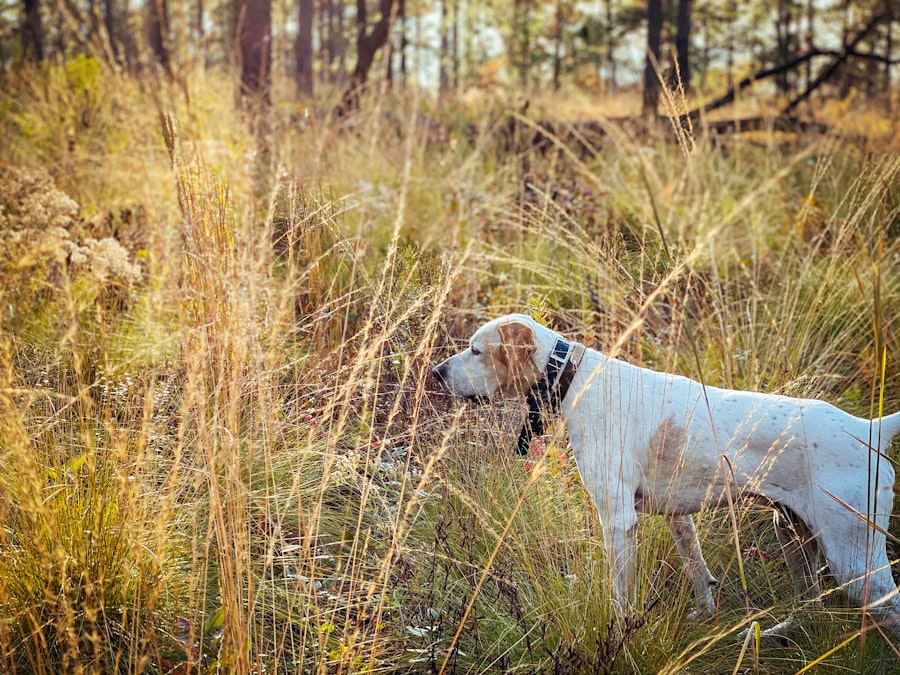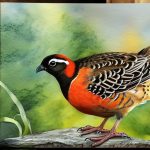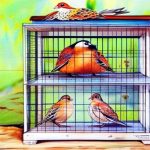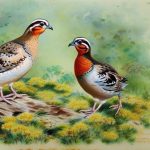Northern Bobwhite Quail, also known as Virginia quail, are small, ground-dwelling birds native to North America. They are popular game birds and are often raised for their meat and eggs. Northern Bobwhite Quail are known for their distinctive call, which sounds like “bob-white,” hence their name. These birds are highly adaptable and can be found in a variety of habitats, including grasslands, agricultural fields, and open woodlands. They are also commonly kept in captivity for breeding and hunting purposes.
Northern Bobwhite Quail come in a variety of breeds, each with its own unique characteristics and traits. These birds are known for their social nature and can often be found in coveys, which are small groups of birds that forage and roost together. They are also known for their quick and agile movements, making them a popular choice for hunting enthusiasts. In recent years, there has been a growing interest in breeding and raising Northern Bobwhite Quail for conservation purposes, as their populations have been declining due to habitat loss and other environmental factors.
Table of Contents
- 1 Physical Characteristics of Northern Bobwhite Quail
- 2 Popular Breeds of Northern Bobwhite Quail
- 3 Breeding and Rearing Northern Bobwhite Quail
- 4 Habitat and Care for Northern Bobwhite Quail
- 5 Challenges and Concerns for Northern Bobwhite Quail Breeding
- 6 Conservation Efforts for Northern Bobwhite Quail
- 7 FAQs
- 7.1 What are the different breeds of northern bobwhite quail?
- 7.2 What are the characteristics of the Texas A&M northern bobwhite quail breed?
- 7.3 What are the characteristics of the Tennessee Red northern bobwhite quail breed?
- 7.4 What are the characteristics of the Georgia Giant northern bobwhite quail breed?
- 7.5 What are the characteristics of the Kansas Bobwhite northern bobwhite quail breed?
Key Takeaways
- Northern Bobwhite Quail are popular game birds known for their distinctive call and behavior.
- They are small, round birds with mottled brown and white feathers, and a short, rounded tail.
- Popular breeds of Northern Bobwhite Quail include the Texas A&M, Georgia Giant, and Tennessee Red.
- Breeding and rearing Northern Bobwhite Quail requires careful attention to temperature, humidity, and nutrition.
- Providing a suitable habitat with proper shelter, food, and water is essential for the care of Northern Bobwhite Quail.
Physical Characteristics of Northern Bobwhite Quail
Northern Bobwhite Quail are small, plump birds with round bodies and short tails. They have a mottled brown and white plumage that provides excellent camouflage in their natural habitat. Their heads are adorned with a distinctive black and white striped pattern, and they have a short, sturdy beak that is well-suited for foraging on the ground. These birds have bright red or orange legs and feet, which are adapted for running and scratching in the soil for food.
Male Northern Bobwhite Quail are slightly larger than females and have a more pronounced white throat and eyebrow stripe. They also have a more vibrant chestnut coloration on their flanks, making them easily distinguishable from females. Females, on the other hand, have a more subdued plumage with less contrast between the brown and white feathers. Both males and females have a characteristic call that is used to communicate with other members of their covey and to attract mates during the breeding season.
Popular Breeds of Northern Bobwhite Quail
There are several popular breeds of Northern Bobwhite Quail that are commonly raised in captivity for hunting, conservation, and breeding purposes. Some of the most well-known breeds include the Texas A&M, Tennessee Red, and Georgia Giant quail. The Texas A&M quail is a popular choice for commercial production due to its fast growth rate and high egg production. These birds are known for their white plumage and are often raised in large-scale operations for meat and egg production.
The Tennessee Red quail is another popular breed known for its vibrant reddish-brown plumage. These birds are prized for their striking appearance and are often raised by hobbyists and conservationists. The Georgia Giant quail is a larger breed that is favored by hunters for its impressive size and robust nature. These birds are known for their strong flying abilities and are often released into the wild for hunting purposes. Each breed of Northern Bobwhite Quail has its own unique characteristics and traits, making them suitable for a variety of different purposes.
Breeding and Rearing Northern Bobwhite Quail
Breeding and rearing Northern Bobwhite Quail requires careful planning and attention to detail. These birds reach sexual maturity at around 16 weeks of age, at which point they will begin to lay eggs. In order to successfully breed Northern Bobwhite Quail, it is important to provide them with a suitable nesting area and proper nutrition. Breeding pairs should be housed separately to prevent aggression and ensure successful mating.
Once the eggs are laid, they should be collected and placed in an incubator set at the appropriate temperature and humidity levels. After approximately 23 days, the eggs will hatch, and the chicks will need to be carefully monitored and provided with a warm, draft-free environment. It is important to provide young quail with a high-protein diet to support their rapid growth and development. As they mature, they can be transitioned to a standard game bird feed that is formulated to meet their nutritional needs.
Habitat and Care for Northern Bobwhite Quail
Northern Bobwhite Quail require a suitable habitat that provides ample space for foraging, roosting, and nesting. In captivity, they should be provided with a spacious outdoor enclosure that is protected from predators and the elements. This enclosure should include plenty of vegetation, such as grasses and shrubs, as well as areas for dust bathing and perching. It is important to provide Northern Bobwhite Quail with a varied diet that includes seeds, insects, and green vegetation to ensure their nutritional needs are met.
These birds are social animals and should be kept in groups or coveys to prevent stress and loneliness. It is important to monitor their behavior closely to ensure that they are getting along well with each other. Additionally, Northern Bobwhite Quail should be provided with access to clean water at all times to prevent dehydration. Regular health checks should be conducted to monitor for signs of illness or injury, and any issues should be addressed promptly by a qualified avian veterinarian.
Challenges and Concerns for Northern Bobwhite Quail Breeding

Breeding Northern Bobwhite Quail can present several challenges and concerns that breeders should be aware of. One of the main challenges is ensuring that the birds have access to suitable nesting areas and that the eggs are properly incubated and hatched. Additionally, maintaining proper nutrition and preventing disease outbreaks are ongoing concerns for breeders. It is important to monitor the health of the birds closely and address any issues promptly to prevent the spread of illness within the flock.
Another concern for breeders is ensuring that the birds have access to suitable habitat that meets their natural behavioral needs. Providing adequate space for foraging, roosting, and nesting is essential for the well-being of Northern Bobwhite Quail. Additionally, protecting the birds from predators such as foxes, raccoons, and birds of prey is an ongoing challenge that requires careful planning and management.
Conservation Efforts for Northern Bobwhite Quail
Conservation efforts for Northern Bobwhite Quail have become increasingly important as their populations have declined in recent years due to habitat loss, predation, and other environmental factors. Organizations such as the National Bobwhite Conservation Initiative (NBCI) have been working to raise awareness about the plight of these birds and implement strategies to protect their natural habitats. These efforts include habitat restoration projects, predator management programs, and public education campaigns aimed at promoting responsible land management practices.
In addition to these efforts, there has been a growing interest in captive breeding programs aimed at reintroducing Northern Bobwhite Quail into suitable habitats where their populations have declined. These programs involve carefully selecting breeding pairs with the goal of producing healthy offspring that can be released into the wild to bolster existing populations. By working together with landowners, conservation organizations, and government agencies, it is possible to make a positive impact on the conservation of Northern Bobwhite Quail for future generations to enjoy.
If you’re interested in learning more about the dietary habits of northern bobwhite quail breeds, you might want to check out an article on Poultry Wizard that discusses the vegetables that quails eat. This informative piece provides valuable insights into the nutritional needs of quails and can help you ensure that your quails are getting a well-balanced diet. You can find the article here.
FAQs
What are the different breeds of northern bobwhite quail?
There are several recognized breeds of northern bobwhite quail, including the Texas A&M, Tennessee Red, Georgia Giant, and Kansas Bobwhite.
What are the characteristics of the Texas A&M northern bobwhite quail breed?
The Texas A&M breed is known for its high egg production, fast growth rate, and ability to thrive in a variety of environments. It is a popular choice for commercial quail production.
What are the characteristics of the Tennessee Red northern bobwhite quail breed?
The Tennessee Red breed is known for its reddish-brown plumage and is prized for its beauty. It is also valued for its ability to adapt to different climates and its good egg production.
What are the characteristics of the Georgia Giant northern bobwhite quail breed?
The Georgia Giant breed is known for its large size and is popular for meat production. It is also valued for its calm temperament and good egg production.
What are the characteristics of the Kansas Bobwhite northern bobwhite quail breed?
The Kansas Bobwhite breed is known for its hardiness and ability to survive in harsh conditions. It is also valued for its good egg production and is often used for hunting and release programs.
Meet Walter, the feathered-friend fanatic of Florida! Nestled in the sunshine state, Walter struts through life with his feathered companions, clucking his way to happiness. With a coop that’s fancier than a five-star hotel, he’s the Don Juan of the chicken world. When he’s not teaching his hens to do the cha-cha, you’ll find him in a heated debate with his prized rooster, Sir Clucks-a-Lot. Walter’s poultry passion is no yolk; he’s the sunny-side-up guy you never knew you needed in your flock of friends!







